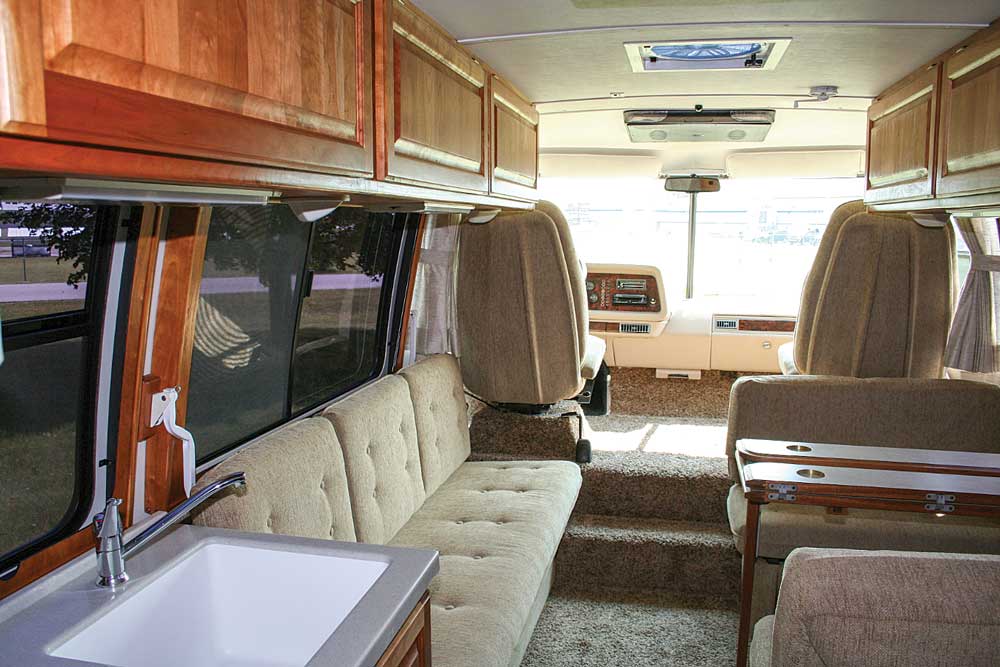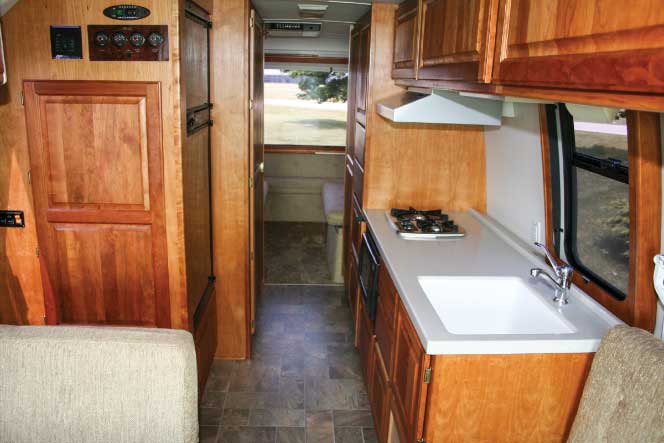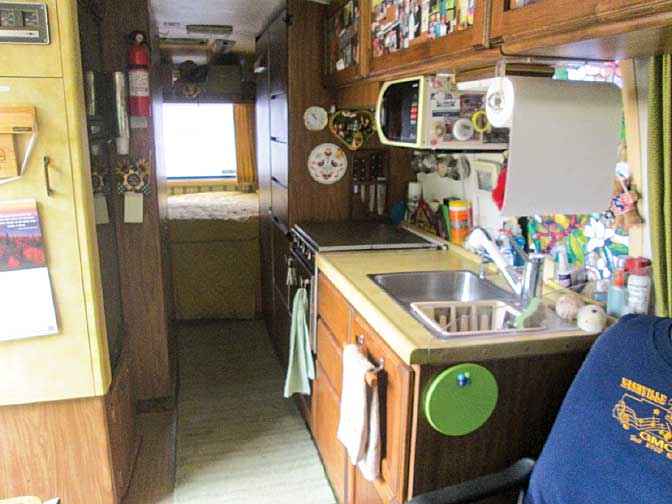Durable 1973-1978 GMC motorhomes are true blasts from the past and still going strong
This article is the next in our series looking at motorhomes that have stood the test of time. They may have miles under their wheels, but they can still make dreams come true. Each has earned the right to be called “the classic ride.”
Before Microsoft, before barcodes, before the first space shuttle flew or the first mobile phone was sold, there was the GMC motorhome.
Proudly introduced in 1973 as the first motorhome that “Doesn’t ride like a truck. Doesn’t look like a box,” more than 13,000 of these then-futuristic vehicles were produced between 1973 and 1978 with model names like Sequoia, Painted Desert, Eleganza II, Palm Beach and others.
After four decades, you might think they would have gone the way of Betamax tapes, but in fact an estimated 7,000 are still registered and on the road today. A testament to the motorhome’s durability and versatility, the GMC is seeing something of a resurgence, with a devoted new following eagerly restoring and re-imagining these vintage vehicles. If longevity is the mark of a classic ride, then the GMC certainly deserves a place on that list.
When you meet a GMC owner, you find yourself ushered into a very unique society. We had no sooner reached out to one local club before we were introduced to an entire network of owners and enthusiasts, all willing and eager to share their knowledge about these unique motorhomes.

Cinnabar renovation includes a Davo couch, leather dash and touch-screen infotainment system. Photo by Cinnabar Engineering
Take Jim and Ada Galbavy of Lake Mary, Florida, who invited us to visit with them and see their beautifully repainted GMC. Jim purchased his 26-foot GMC 14 years ago for $15,000 after looking at a range of used Class A, B and C motorhomes. The retired U.S. Army aircraft equipment specialist was impressed with the GMC’s body construction. Like an airplane fuselage, a complete cage of heavy-gage aluminum ribs and stringers is mounted on a wide steel chassis. Below the beltline the exterior skin panels are made of solid reinforced fiberglass; above, body and roof are constructed of sheet aluminum. The result is a body with a sleek, futuristic shape that ages well, making it a good candidate for repainting, which is what Jim did. He went with a neutral beige-and-white exterior and a striped awning, resulting in a modern appeal while still keeping some of the GMC’s vintage look.
For Ken and Janet Frey of Philadelphia, it was not the body but the chassis that convinced them to purchase their 1976 GMC some 30 years ago. They were visiting family in Arizona and came upon an ad in the local paper about a “Cabin fever” sale at a U-Haul agency. They checked it out and got their first glimpse of a used Palm Beach model GMC. As soon as he heard there was a 455 Oldsmobile Toronado engine under the hood, Ken was sold. As an auto mechanic at an Oldsmobile dealership, he knew its quality, dependability and impressive power.
“We call it our hot rod with plumbing,” Janet laughs.
They have garage-kept their GMC, thus preserving its unique and original lime-green exterior. The motorhome did need restriping, a process that involved the nasty job of removing the decals with a heat gun. An auto-detailer friend did the restriping, even adding a new Palm Beach logo. They have found that keeping the original colors has led to lots of attention while traveling, and they seldom go anywhere without getting smiles and waves – and sometimes something more.

The galley of this renovated GMC Palm Beach sports solid cherry cabinets, solid-surface counters and modern appliances. Photo by Cinnabar Engineering
“We were driving through South Dakota, a long, straight stretch, and a car full of teenagers passed us, and you know, they are pretty hard to impress,” Janet remembers. “They pulled off, and a little while later they pulled next to us again, and they held up a handmade sign that said, ‘WE LOVE YOUR CAMPER!’”
One reason the GMC remains so popular is that it was ahead of its time in many respects. It was designed for comfort, both on the road and in an RV park. With front-wheel drive, a low roofline and a low center of gravity, the GMC handles easily. The air suspension provides a smooth ride, and the wide, panoramic windows ensure superior visibility while traveling. Unlike many smaller motorhomes of that era, it boasts 6 feet, 4 inches of headroom, and features an unusual 15-inch ground-to-floor clearance for comfortable entry and exit. Built in 23- and 26-foot lengths, GMC offered three models differing only by color; however, empty GMCs (Transmodes) were upfitted and sold by several other companies under their brand names, providing up to 15 different interior configurations.
The standard GMC motorhome came with a Davo (sliding) couch behind the driver’s seat that unfolds into two bunk beds; the galley consisted of a double sink, a 6-cubic-foot refrigerator, LP-gas range and oven. Also standard was the molded fiberglass wet bath module, which includes a shower, mirrored sliding door medicine cabinet, sink and an Aqua-Magic toilet. This is opposite the closet module and adjacent storage drawers. The rear bedroom features twin sofas that create a queen-size bed.
But regardless of its configuration on the showroom floor, don’t expect to see a stock GMC motorhome today. In more than four decades of use, every one we have seen has been modified in ways big and small to suit its owners.
“You can go inside 10 of these motorhomes, and you won’t see two alike,” Jim Galbavy notes.
Many owners, like the Galbavys, had their units stripped to the bare bones and then re-outfitted with modern cabinetry, furnishings and appliances. While some owners opt for a total interior renovation, we were charmed by those like the Freys, who have updated while holding on to that 1970’s look. Janet and Ken kept the original gold Formica and double-bowl stainless-steel sink in the kitchen but replaced the barrel chairs with residential office chairs and the green shag carpet with a mix of vinyl flooring and residential plush carpet. They replaced the rear sofas with a double bed, repurposing one as living-area seating in place of the dinette. Janet wasn’t happy with the louvered cabinet doors, which collected dust, so a cabinetmaker friend replaced the fronts with solid wooden faces on lower sections and Plexiglas “picture frames” on some upper cabinets to allow for a photo gallery.
Because of its size and design, storage in the original GMC design is limited. Ken solved this problem uniquely by adding a five-drawer toolbox next to the sofa and covering the two sides that faced the living area with wainscoting to resemble an end table. The result is quick and easy access and additional table space.
As cool as the GMC is, there has to be more to its continued existence than its futuristic design. Wes Caughlan, Cinnabar Engineering’s president and an original GMC motorhome owner, has the answer.
“You know what makes something a classic ride? Parts. Without available parts, older motorhomes can’t survive,” he explains.
Cult Classics
For those wanting to collect this “cult” classic, there are GMC motorhomes in all conditions available on the market. If you are looking for a restoration project, you can pick one up for less than $5,000. For a GMC that has been partially restored but will require some additional work, expect to pay $20,000-$30,000. Fully restored motorhomes vary widely in the amenities that have been added, and average $45,000-$50,000. Complete renovations cost much more and generally come with a warranty. To learn more, check out GMC Motorhomes International at www.gmcmi.com, or GMC Motorhome News at www.thegmcmotorhomepeople.com/news.
In the case of the GMC motorhome, Cinnabar Engineering purchased the rights to manufacture and distribute original GMC motorhome parts and publications in the 1980s. The result is a supply chain that keeps these vintage beauties on the road. The Freys agree, noting that they have been able to get many of the needed parts from Cinnabar Engineering. The company also specializes in complete GMC motorhome renovations and published GMC Motorhome News, which was dedicated to the preservation of a classic and timeless vehicle.
Another valuable resource is GMC owners themselves, available on the Blacklist (www.gmcmi.com/black-list), a nationwide directory of volunteers who agree to be on-call for assistance to fellow owners on the road. Galbavy notes that he answered his share of distress calls from owners stranded on Interstate 95 when he lived in Virginia.
“We are like a family. We have to help each other out,” he explains.
This sense of camaraderie may be the GMC motorhome’s greatest strength. There are active GMC motorhome clubs nationwide, known for enthusiasm for their coaches. Janet and Ken Frey attend monthly rallies, plus the GMC International club’s conventions twice a year. The Galbavys are active members of a Florida club. Spend 10 minutes with a GMC owner and you will find yourself initiated into their absolute passion for their motorhome.
“We have a motto: It’s not a club, it’s a cult,” Ada Galbavy laughs.
Which makes the GMC motorhome not just a classic, but a “cult classic” ride.
We’re on the lookout for classic rides! If you, or someone you know, has a terrific older motorhome, send an email with info and a photo to Ann Eichenmuller, and your RV might be featured in MotorHome magazine!



